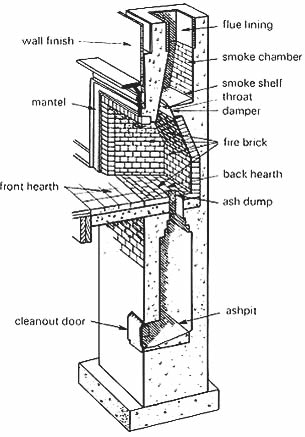THE MAGIC AND THE MYSTERY
Fireplaces are no longer used as the primary source for heating homes, but the magic of a fire stills makes a fireplace a valued part of any home. There are few things nicer than a cheery fire, especially on a cold winter night. By the same token, there are few things more distressing than a fireplace which doesn't draw - belching smoke into the home, chasing people out, setting off smoke detectors, and dirtying everything in sight. Why do some draw perfectly and others so poorly?
GOOD DESIGN
There are many factors which affect fireplace performance. Some of the more important are listed here:
Ratio of Fireplace Opening to Chimney Flue Size: The area of the flue should be roughly one-twelfth (1/12) the size of the opening area.
Chimney Height: The taller the better, but at least 3 feet above the roof and 2 feet higher than anything within 10 feet of it.
Damper Size and Location: Full width of firebox and at least 6 inches above the top of the opening. The damper is usually closer to the front of the fireplace than the back.
Smoke Chamber Slope and Smoothness: The chamber above the damper should be as smooth as possible, and should slope no more than 45 degrees as it funnels the smoke from the damper opening into the chimney. Most fireplaces break at least some of the rules of good design and yet many work well despite this. Fireplace design is more of an art than a science. Because there are so many factors which affect the draw, it is impossible to know how "perfect" the unit has to be to work. What about solving the problem of a fireplace that doesn't draw well?
IMPROVING THE DRAW
 Reduce the Opening Size: This can be achieved by laying an additional row of firebrick on the floor of the firebox. Even before this is done, the solution can be simulated by holding a piece of metal over part of the opening and watching to see if the draft improves. Reduce the Opening Size: This can be achieved by laying an additional row of firebrick on the floor of the firebox. Even before this is done, the solution can be simulated by holding a piece of metal over part of the opening and watching to see if the draft improves.- Extend the Chimney: This is expensive but often successful. Less expensive alternatives include a rain cap or a metal draft hood which rotates with the wind so that smoke is always released downwind.
- Move the Fire Back: Often the fire is simply too close to the front of the firebox.
- Add Air: A fireplace which is starved for air won't work properly. Sometimes opening a window in the room with the fireplace will supply enough air. Fireplace draw is more difficult to achieve if the house is under negative pressure. Don't have exhaust fans on while trying to start a fire. Most furnaces also work like exhaust fans. It is easier to start a fire when the furnace is in an off cycle. Glass doors help to protect the fireplace from negative pressure effects in the house, especially if combustion air can be brought in from outside.
- Warm the Flue: This is a trick most people know about. Pushing a burning piece of rolled-up newspaper up past the damper will help overcome the column of cold air in the chimney and allow a good draft to be established quickly.
We don't suggest damper or smoke chamber modifications because they are expensive and should be considered last resorts.
Illustration is from the Carson Dunlop Illustrated Home
<< Back to Technical Library |